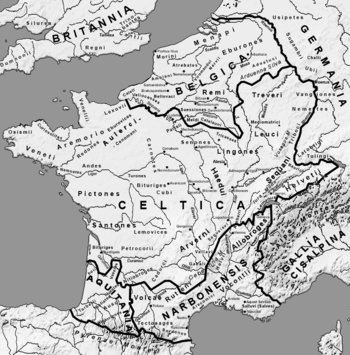Senones


The Senones (Ancient Greek: Σήνωνες) were an ancient Celtic Gallic culture.
Senones of Gallia Cisalpina
They joined Bellovesus' migrations towards Italy, together with the Aeduii, Ambarri, Arverni, Aulerci, Carnutes and Senones.[1]
In the year of 400 BCE they crossed the Alps and, driving out the Umbrians settled on the east coast of Italy from Forlì to Ancona, in the Ager Gallicus, and founded the town of Sena Gallica (Senigallia), which became their capital. In 391 BCE, under the chieftain Brennus, they invaded Etruria and besieged Clusium. The Clusines appealed to Rome, whose intervention, accompanied by a violation of the law of nations, led to war, the defeat of the Romans at the Battle of the Allia (18 July 390BCE) and the sacking of Rome.
For more than 100 years the Senones were engaged in hostilities with the Romans, until they were finally subdued (283 BCE) by P. Cornelius Dolabella and driven out of their territory. Nothing more is heard of them in Italy. It is possible that they formed part of the bands of Gauls who spread themselves over the countries by the Danube, Macedonia and Asia Minor. A Roman colony was established at Sena, called Sena Gallica (currently Senigallia) to distinguish it from Sena Julia (Siena) in Etruria.
Senones of Gallia Transalpina
A branch of the Senones (or a different tribe of the same name) settling the district which now includes the departments of Seine-et-Marne, Loiret and Yonne from 53-51 BCE were engaged in hostilities with Julius Caesar brought about by their expulsion of Cavarinus, whom he had appointed their king. In 51 BCE, a Senonian named Drappes threatened the Provincia, but was captured and starved himself to death. From this time the Gallic Senones disappear from history. In later times they were included in Gallia Lugdunensis. Their chief towns were Agedincum (later Senones, whence Sens), Metiosedum (Melun; according to A. Holder, Meudon), and Vellaunodunum (site uncertain).
References
- ↑ Livius, Ab Urbe condita 5.34-35.3.
 This article incorporates text from a publication now in the public domain: Chisholm, Hugh, ed. (1911). "article name needed". Encyclopædia Britannica (11th ed.). Cambridge University Press.
This article incorporates text from a publication now in the public domain: Chisholm, Hugh, ed. (1911). "article name needed". Encyclopædia Britannica (11th ed.). Cambridge University Press.
External links
- Harris, W., R. Talbert, T. Elliott, S. Gillies. "Places: 413311 (Senones)". Pleiades. Retrieved February 29, 2012.
- "www.senones.fr".
